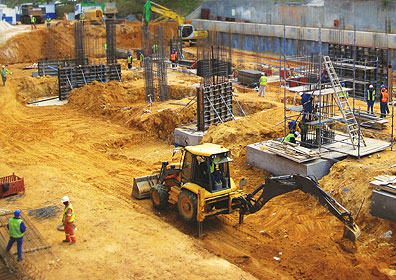Leading Consulting Civil Engineering Companies for Framework Projects
Leading Consulting Civil Engineering Companies for Framework Projects
Blog Article
How Consulting Engineers Enhance Geotechnical Engineering Projects: Insights Into Their Knowledge, Approaches, and Collaborative Approaches
Consulting engineers are critical in enhancing geotechnical design jobs, applying their specialized expertise to navigate the intricacies of subsurface problems. Their methods encompass an array of site investigation strategies, consisting of Criterion Penetration Examinations (SPT) and Cone Penetration Examinations (CPT), which inform essential choices during the layout and building stages. Their collective methods foster interaction among varied project stakeholders, ultimately forming the project's trajectory. As we take a look at the multifaceted functions these professionals play, it ends up being clear that their payments prolong past technical competence, prompting a more detailed look at the effects for project success.
Duty of Consulting Engineers
The competence of seeking advice from designers in geotechnical engineering is fundamental to the successful implementation of building and construction tasks. These specialists play a critical function in analyzing dirt and rock buildings, which are critical elements affecting layout and construction decisions. By carrying out complete website investigations, seeking advice from designers accumulate crucial information that informs the design procedure, ensuring projects are built on stable and ideal ground.
Consulting designers additionally give invaluable insights into threat monitoring (geotechnical geologist). They recognize possible geotechnical dangers, such as landslides, soil liquefaction, and settlement issues, enabling stakeholders to apply reliable reduction techniques. Their expertise aids in enhancing structure layouts, which can cause considerable cost financial savings and boosted security
Moreover, speaking with engineers work as a crucial link between task proprietors, designers, and professionals. Their ability to convert intricate geotechnical information into workable recommendations fosters cooperation and helps with notified decision-making throughout the task lifecycle. This multidisciplinary approach not just improves task efficiency however also guarantees conformity with regulatory criteria and ideal practices.
Trick Methodologies in Geotechnical Design

One key methodology is site examination, which entails performing field examinations and research laboratory evaluations to gather data on subsurface conditions. Strategies such as Requirement Infiltration Screening (SPT) and Cone Infiltration Screening (CPT) are extensively made use of to review dirt stratigraphy and stamina. In addition, geophysical methods, consisting of seismic and electrical resistivity studies, supply non-invasive means to assess subsurface qualities.
An additional crucial approach is mathematical modeling, which makes it possible for engineers to imitate different scenarios and forecast how soil-structure communications will certainly behave under different loading conditions. Limited Component Evaluation (FEA) is an usual strategy used in this context.
In addition, the layout of foundations, keeping structures, and earthworks relies heavily on these methodologies - geotechnical geologist. By integrating innovative logical tools with field information, seeking advice from designers can develop tailored services that address specific project challenges, ultimately adding to the stability and safety of construction tasks
Value of Dirt Analysis
Soil analysis acts as a foundational component in geotechnical engineering, providing crucial insights right into the physical and chemical buildings of soil essential for effective building and construction planning. Comprehending dirt attributes is crucial for identifying its load-bearing capability, drainage actions, and possibility for negotiation or instability. Thorough soil examinations, consisting of tasting and research laboratory testing, assistance recognize specifications such as dirt type, moisture web content, density, and click here to read shear strength.
These evaluations inform the option of suitable building and construction techniques and materials, eventually affecting project safety and security and long life. For example, cohesive soils may require different structure styles contrasted to granular soils, necessitating tailored engineering services. Additionally, dirt evaluation help in recognizing contaminants that might position threats to human health and go to this site wellness or the setting, enabling for the advancement of reduction strategies.
Incorporating soil analysis right into the onset of task development helps to reduce unpredicted challenges, guaranteeing that engineers can anticipate and attend to prospective problems prior to they escalate. By establishing an extensive understanding of the site conditions, seeking advice from designers can enhance style performance and decrease costs, therefore enhancing the general success of geotechnical engineering jobs.
Collective Techniques in Tasks
Successful geotechnical projects often depend upon collective techniques that unite diverse competence from different disciplines. Effective cooperation among speaking with engineers, rock hounds, environmental researchers, and construction professionals is essential for addressing intricate challenges and optimizing job results. By leveraging the distinct abilities and knowledge of each staff member, tasks can gain from an alternative understanding of the site conditions, regulative requirements, and engineering restraints.
Normal interaction and interdisciplinary meetings promote the sharing of understandings and foster a culture of teamwork. These joint efforts make it possible for the recognition of possible dangers early in the task lifecycle, enabling prompt mitigation approaches. Integrating responses from stakeholders, including neighborhood neighborhoods and regulative agencies, guarantees that all perspectives are thought about, enhancing job acceptance and compliance.
In addition, the combination of sophisticated modern technologies, such as Geographic Info Solution (GIS) and Structure helpful resources Details Modeling (BIM), further enhances partnership. These tools permit for the real-time sharing of data and visualization of geotechnical problems, advertising educated decision-making. Inevitably, a collective method not only improves project execution yet additionally lays the structure for ingenious solutions to complex geotechnical engineering challenges.
Influence On Task Results

Consulting designers use innovative methodologies such as risk analysis and predictive modeling, which boost the precision of job projections. Their capability to integrate cutting-edge innovations, like geotechnical instrumentation and information analytics, further refines the layout and building and construction processes. As an outcome, projects experience boosted performance, reduced prices, and reduced delays.
Furthermore, promoting reliable interaction and cooperation amongst staff member enhances analytical capacities. When challenges occur, a united front permits for speedy identification of solutions, protecting against prospective setbacks. Ultimately, the collective initiatives of speaking with engineers add to better results, guaranteeing that projects fulfill both regulative standards and client assumptions.
Conclusion

Report this page